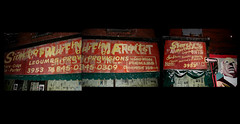Two Kinds of Spirit
2005 was the year we found and lost Patience Gray...
I remember quite vividly that Kramerbooks in Washington, D.C. stocked Honey From a Weed when I worked there years and years ago. Attracted by the strange primitivist artwork that graced its cover, I used to take a look at it from time to time, but, although I was already big on cookbooks at the time, I hadn't really developed my taste for food writing (or for travel writing, for that matter) and the book struck me as arcane. I was young and foolish, I guess, impatient. A few years ago, I started to hear references to Patience Gray again from time to time, and I made a note to take a closer look at some future date. It wasn't until I came across Paul Bailey's testimonial to the lasting glory of Honey From a Weed in the Food and Drink section of the Financial Times in September of 2004, though,

that I decided I absolutely needed to track it down. Gray's enigmatic account of her culinary odyssey across the Mediterranean from Greece to Italy to Spain, her cookbook and handbook to living a life most extraordinary, to living a life composed of feasts and fasts, suddenly made every bit of sense to me. Bailey's biography of Gray further cinched the deal. His account of her life--one that encompassed everything from a surprise bestseller in 1957 with her first cookbook, Plats du Jour (the book that, along with the work of Elizabeth David, which it eclipsed in sales, was among the first to teach many aspiring British hostesses about the joys of continental cuisine), to a three-year stint as the editor of the women’s page for the Observer (during which time she introduced the radical notion that women might actually want to learn about art, design, and culture in general instead of simply being instructed in the finer points of consumption, and then got fired for this approach), to a near decade-long journey back and forth across the Mediterranean with the sculptor Norman Mommens before they finally settled in southern Italy’s Apulia region--only added to her mystique and to the mystique of Honey From a Weed. You see, at the time that Gray finished writing her masterwork and began to shop around for a publisher, she had long been out of the loop, her former celebrity largely forgotten. Plus, that which makes the book so unique and enchanting—its unorthodox meandering style, its unclassifiable nature, its long expositions on topics like edible weeds, abstinence (fasting is one of the book's major themes), and anarchism (I kid you not. After proposing a digression at the beginning of a chapter entitled “Two Kinds Spirit," Gray writes: "Many people think of anarchism as a symptom of social breakdown, they confuse it with anarchy. The distinction becomes apparent in Kropotkin's memoirs. Anarchism--which admits both individualism and human brotherhood--is a positive force. And anyone who has spent time in Carrara [Tuscany] recognizes it as a way of life." The "two kinds of spirit"? Anarchy and home-distilled grappa.)—was exactly what made it a hard sell to London’s 1980s publishing scene. Finally, her literary agent put Gray in contact with Alan Davidson, the food writer and former diplomat who ran Prospect Books with his wife. It quickly became a cult classic in both Britain and America among those eager for a more philosophical approach to cuisine, and although it could hardly be accused of being a publishing blockbuster, it has never gone out of print over the last 20 years. I gave Michelle a copy of Honey From a Weed for Christmas last year, and we both began to read it eagerly. In March, at the age of 87, Patience Gray passed away.

2005 was also the year we lost Simcha and Fanny Schwartz Leibovich…
I still remember moving to Montreal at the age of 18. I’d been coming to Montreal since I was a kid to visit family and friends, and my knowledge of the city was good but limited. I knew places like Olympic Stadium, Central Station, and Atwater Market well, but Prince Arthur Street was the only thing I knew about the Plateau. Wandering up and down the Main for the first time was a revelation, and I felt instantly at home among the strange old five-and-dime shops, the Eastern European delicatessens, the Jewish bakeries. Hell, there was still a newsstand at the corner of Pine and St.-Laurent at that time. Things seemed frozen in time and I lost myself in the charms of a bygone era. By the time I got back to Montreal, things had changed considerably along the Main as they had in other parts of town, but because of the nature of the Main it was all the more noticeable there. Some places had relocated, some had changed for the worse, others had just disappeared altogether, only to be replaced by hair salons and a variety of lifestyle boutiques. In spite of this, some of the die-hards were still around, and although some of these classics seem like they’ll be around indefinitely—places like Schwartz’s, Charcuterie Hongroise, and Slovenia—so much of what remained attractive to me along the Main has disappeared in the span of just a few short years: Louis Pecker and his little shop of wonders, Warshaw’s supermarket, Boulangerie Saint-Laurent, even though their product had taken a nosedive since I first developed my B.S.L. ritual in the late-‘80s, and now Simcha’s. Simcha Leibovich had been a fixture on the Main for almost 60 years and Simcha’s was one of those businesses that really contributed to the area’s mystique. Simcha started his first grocery with his wife Fanny in the Saint-Jean-Baptiste Market just two years after his arrival to Canada from Romania in 1946. In 1966, when the Drapeau administration decided to raze the market in anticipation of the World Exposition, Leibovich moved his business to the location it would occupy for almost 40 years, a lovely shopfront with big windows and a strange palimpsestic sign on the corner of St.-Laurent and Napoleon that had become almost as iconic along that stretch of St.-Laurent as Schwartz’s or The Main or L. Berson & Sons Monuments.

Business at Simcha’s had become quiet over the last few years. Prices at Segal’s, just up the street, are unbelievably low, but I never really understood why they attracted customers in droves while Simcha’s had ceased to long ago. Realizing that times were tough, Michelle and I took a vow a few years to give Simcha’s as much business as we could afford to, even if we didn’t really need something. Secretly we hoped that he and Fanny would adopt us and that we could take Simcha’s over when they grew tired of the day-to-day grind, keeping things just as they’d always been (the eggs visible from the window, the sauerkraut homemade).
In the end, Simcha continued to be there every day, donning his trademark newsboy cap and holding down the fort. [If you want to get a sense of Simcha’s drive and dedication, check out The Société de développement du boulevard Saint-Laurent and Action Terroriste Socialement Acceptable’s (ATSA) lovely homage to him.] Last February I remember panicking one night when I passed Simcha’s and noticed that the windows were covered up with newspaper. My fears were warranted, as it turns out, because Fanny had passed away. But a few weeks later, looking a bit frailer perhaps, Simcha opened the shop back up again and went back to work. In December the windows at Simcha’s got papered up once more.

R.I.P.
aj









3 comments:
we can only hope that someone does something loving with the store. let's all keep our fingers crossed..
A touching tribute ... beautiful post!
we definitely disagree on the concept of anarchy, but then again, we fully agree on Patience Gray... if you haven't already be sure to collect every single issue of PPC next. Back when banks were foolish enough to give me credit one of the very first things I did was to purchase all the back issues on credit card, I had fallen hard over the few issues I had been able to find and the £300 or whatever was more than worth it. Still in the Patience Gray neighb, go for Simple French Food by Richard Olney, and after that his excellent autobiography. Gray's Plats du Jour is a very pretty little book too.
Excellent blog btw!
Post a Comment